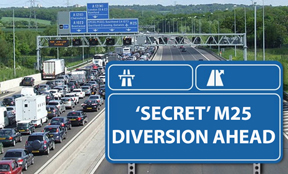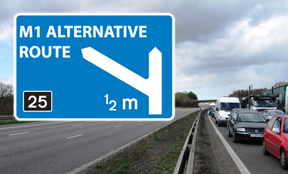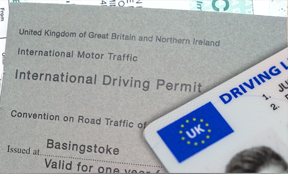
With Brits covering 68.2 billion motorway miles each year (2022), it's inevitable that many will suffer a breakdown or even find themselves involved in a collision that requires their car to be recovered from the carriageway - so how much could this cost and how is it arranged?
With the number of cars removed from motorways under official powers increasing by around 30% over the past five years, and drivers paying around £25million in the process, motoring journalist and expert Pete Barden looks at how cars are recovered from motorways and the costs involved if the worst happens.
 Find out how much you could pay if you need to have your car recovered
from a motorway in the UK (Credit: free image)
Find out how much you could pay if you need to have your car recovered
from a motorway in the UK (Credit: free image)
-
TABLE OF CONTENTS
-
What should I do first in a motorway breakdown?
-
Can I call my own recovery firm?
-
What if car is not in a safe place?
-
When will a car be removed as a statutory removal?
-
What if I need to leave the car on the motorway?
-
How much will it cost to have the car recovered?
-
When will I get free recovery for my car?
-
Will free recovery take my car to my destination?
-
How do I tell traffic officers I've broken down or crashed?
-
What to do after a breakdown or collision
What should I do first after breaking down on a motorway?
Before worrying about recovering your car, you must first consider your safety and that of other road users who could be affected by your stranded car.
Remember, in the event of an emergency - such as a breakdown in a live lane - you are permitted to use your mobile phone.
First thing to do is call 999. The emergency services and speak to the police, who will let National Highways know so it can remotely close lanes - if the breakdown is in a live lane or other dangerous position. The emergency call will also ensure either Traffic Officers or Police Officers are dispatched.
You also inform the operator if you are a vulnerable motorist, who may have mobility issues, for example.
Can I call my own recovery firm if I break down on the motorway in the UK?
Yes. Providing your vehicle is in a 'safe' position and not blocking lanes, and is not left waiting too long for recovery, it is likely you will be able to use your own firm or choice, or breakdown service.
What if I can't move my car quickly, or it is not in a place of safety?
If the car is blocking live traffic lanes, causing danger to other users, has been left standing for too long, or even been abandoned, a National Highways traffic officer will attend the scene and call for a statutory removal.
This 'statutory removal' is carried out under the Removal and Disposal of Vehicles (Traffic Officers) (England) Regulations 2008, and the owner must obey the National Highways traffic officer or face a fine of up to £1,000.
When will a car be removed as a statutory removal?
The traffic officer may order a statutory removal in the following circumstances:
- The driver is unable to arrange vehicle recovery within a reasonable time
- The officer believes the vehicle recovery arrangements proposed by the driver are unsuitable or unsafe
- If the owner has left their vehicle unattended
- The car or other vehicle breaks down or is damaged in a live lane and can't be cleared to a safe area
What if I need to leave the car on the motorway?
If you need to leave a car that has broken down or been damaged, you must inform a National Highways traffic officer. You can do this on the nearest emergency phone. Markers at the side of the hard shoulder will tell you the direction and distance of the nearest phone.
How much will it cost to have the car removed from the motorway?
The removal could be free under certain circumstances - see section below - but most of the time the owner will be identified and charged.
The car will not be released until all of the outstanding recovery cost has been paid.
The costs for recovery from a motorway are covered by government legislation for non-commercial recovery - these are as follows:
|
Vehicle position and condition |
Vehicle equal to or less than 3.5 tonnes MAM†. |
Vehicle exceeding 3.5 tonnes MAM but equal to or less than 7.5 tonnes. |
Vehicle exceeding 7.5 tonnes MAM but equal to or less than 18 MAM†. |
Vehicle exceeding 18 tonnes MAM†. |
|
Vehicle on road, upright and not substantially damaged or any two wheeled vehicle whatever its condition or position on or off the road. |
£150 |
£200 |
£350 |
£350 |
|
Vehicle on road but either not upright or substantially damaged or both. |
£250 |
£650 |
Unladen - £2,000 Laden - £3,000 |
Unladen - £3,000 Laden - £4,500 |
|
Vehicle, excluding a two wheeled vehicle, off road, upright and not substantially damaged. |
£200 |
£400 |
Unladen - £1,000 Laden - £1,500 |
Unladen - £1,500 Laden - £2,000 |
|
Vehicle, excluding a two wheeled vehicle, off road but either not upright or substantially damaged or both. |
£300 |
£850 |
Unladen - £3,000 Laden - £4,500 |
Unladen - £4,500 Laden - £6,000 |
When will I get free recovery for my car on a motorway?
If your car breaks down or suffers damage in areas of roadworks, National Highways will be able to sort out free recovery to cut congestion and maintain safe running of the motorway.
Free recovery will only be applied if one or more of these conditions are met:
- the hard shoulder is being used as a running (“live”) lane
- there is no direct access to the hard shoulder, lay-bys and emergency refuges
- we have reduced carriageway lane widths
- we have suspended use of the emergency telephones
Subscribe for free motoring and travel news here - support independent journalism
Will the free motorway recovery take my car home or to my destination?
No. The free recovery will take the damaged or broken down car to a place of relative safety, this is likely to be something like a hard shoulder that is not being used as a live running lane or an emergency refuge area.
From this position, the car driver/owner will need to organise their own recovery to take the vehicle onwards.
How do I tell traffic officers I've broken down or crashed?
If your car is in a safe place, you can call on an emergency phone. If it is in a dangerous position or there are people injured, call 999 as soon as it is safe to do so. Remember, in an emergency situation, you are allowed to use a mobile phone while behind the wheel.
Highways agency breakdown number (now known as National Highways)
If possible and safe to do so, you and the passengers should get behind barriers at the side of the motorway. You can use your mobile phone to call National Highways - who control safety officers and can close lanes remotely - on 0300 123 5000 if you're unable us an emergency roadside phone.
What to do after a breakdown or collision on a motorway
Motorways are dangerous places for stationary cars and their occupants. Always follow this safety advice from the National Highways website if you break down on the motorway or find yourself involved in a collision.
- get away from the traffic: exit the motorway or get to an emergency area or hard shoulder and use the free phone provided
- if that’s not possible, move left onto the verge
- get out of the left side of your car and behind the barrier if you can and it is safe to do so
- get help – contact your breakdown provider or National Highways on 0300 123 5000.
- if you break down in moving traffic and cannot leave your car, keep your seatbelt and hazard lights on and call 999
Edmund King, AA president said: 'As well as checking your vehicle over before your journey, you should also check you have the phone number or app of your breakdown provider should the worst happen and you need assistance.'
How likely am I to break down on a motorway?
Research from National Highways, covering the pre-pandemic period of 2019, revealed that almost 225,000 cars broke down on motorways in the 12 months from April 2018.
The M1 is the motorway that saw most breakdowns, with just under 140,000 vehicles stopping in the five years up to 2019. This was followed by the M25 and M6 motorways.
Motorways with most breakdowns reported
Data from National Highways (previously Highways England) revealed the motorways where most breakdowns occurred in the five years from 2014 - 2019. The M1 proved to be the most likely road for cars to break down, closely followed by the ever-popular M25.
Top 10 motorway breakdown locations by junction in England, 2023
|
Rank |
Location |
No of incidents |
|---|---|---|
|
1 |
M1 J14/15 |
1,787 |
|
2 |
M62 J11/12 |
1,766 |
|
3 |
M1 J15/14 |
1,752 |
|
4 |
M6 J15/14 |
1,595 |
|
5 |
M62 J12/11 |
1,522 |
|
6 |
M6 J14/15 |
1,501 |
|
7 |
M25 J5/6 |
1,451 |
|
8 |
M25 J25/24 |
1,447 |
|
9 |
M6 J19/18 |
1,371 |
|
10 |
M6 J18/19 |
1,364 |
Most read motoring content
Take a look at more of our top motoring-related content here...
-
Secret exits on the M25 and other motorways in the UK
-
Can I use an electric scooter to get around in lockdown?
-
Are car washes still open during hosepipe bans in the UK?
-
How to spot a fake undercover police car
-
Will I get a 7-month extension to my driving licence photocard?
-
Do I need to pay the Dartford Crossing charge on Sundays?
-
Will I get a 6-month extension to my MOT
-
Will I get a speeding ticket after being flashed
-
Do I need an international driving permit for France and Spain
-
Secret parking offences you're committing revealed
-
Alternative routes for beating jams on the M25
-
Alternative routes for the M1 motorway
-
Alternative routes for the M6 motorway
-
How old are my tyres - find out instantly here
-
What are the black dots on my windscreen for?
-
Are my sunglasses legal for driving?
Author: Pete Barden
Twitter: @pete_barden
Pete Barden is a qualified journalist who has written and produced for publications including The Sun (thesun.co.uk), New Statesman Media Group, Whatcar? (Whatcar.com) Stuff Magazine (Stuff.tv), Fastcar Magazine (Fastcar.co.uk), Maxim Magazine and UK broadcast stations within the Heart network (Formerly GCAP). Pete specialises in motoring and travel content, along with news and production roles. You can find out more about Pete Barden on LinkedIn.











